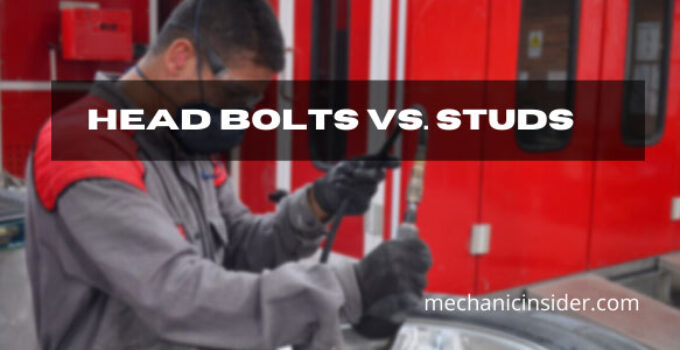Deciding between cylinder head bolts vs. studs is a regular debate for mechanics. It depends critically on the functionality of the vehicle. Although bolts and studs perform similar tasks, each has unique characteristics and structures.
The visual difference is that head bolts are partially threaded, whereas the studs are fully threaded. Also, bolts have a distinct flat top which the studs don’t have. If you notice carefully, you can easily differentiate between the two following these factors.
Using 5.3 head bolts vs. studs in vehicle engines can have dramatic consequences on the performance if not used smartly. Even though both the items perform the same function, they differ in some aspects.
Differences Between Head Studs And Head Bolts
One crucial thing that differentiates both things is that bolts are fully or partially threaded most of the time. On the flip side, studs are usually threaded on the ends, and the middle section is left unthreaded. Another thing to notice is that bolts always have heads, but the studs don’t.
Some factors must be considered while evaluating different aspects of studs and bolts. There are factors like overall engine performance, torque pressure, etc. The 6 0 Powerstroke head bolts vs. studs display these differences among them.
The acceleration and the power of an engine is the parameter that is considered while choosing the suitable head fastener. Naturally, a heavy-duty race car will have an entirely different engine fastener than a regular everyday-purpose vehicle.
Here are some of the fundamental differences between 7.3 head bolts vs. studs and a brief discussion about the factors:
|
Factors |
Head Bolts |
Head Studs |
|
Torque Efficiency |
Both vertical and rotational torques play their parts |
Only vertical torque applicable |
|
Strength |
Strong |
Better strength than head bolts |
|
Fastener Design |
More stable |
Concentric |
|
Head Assembly |
Used for maintenance |
Used for assembling |
|
Appearance |
Partially threaded |
Fully threaded |
Head Bolts
Is head bolts vs. studs a valid comparison? In some cases, it is.
Head bolts are flat-headed fasteners that are used for the replacement of parts. These are less costly and extremely useful for low-end equipment. This instrument is mainly used for maintenance as it offers both vertical and rotational strength.
Engine Head Fastener Design
Between the 6.0 Powerstroke head bolts vs. studs, the head bolts are designed to have a more stable structure. These bolts are cold-fabricated. This helps increase the integrity of the bolts.
Because of this, the bolts are sometimes thermally treated before they are cut. This treatment allows the bolts to have better durability and higher strength. Hardened washers are also provided with them.
Some manufacturers offer wide flange dimensions with head bolts. This reduces the requirement for bolt or valvetrain removal during cylinder maintenance.
Torque Efficiency
A bolt is installed into place by torquing during the maintenance or assembling process. The bolt has to be swirled into the slot to secure it into place.
Two forces work simultaneously to make this happen – a vertical clam force and the twisting force. This means that when the engine starts to accumulate some load, the bolt will resist it by stretching and twisting.
Between 53 head bolts vs. studs, the bolt reacts with two separate forces together, the security that the head provides gets a bit reduced. That’s why the seal becomes less reliable when used in high-powered engines.
Engine Head Assembly
Head bolts are convenient if used for disassembling or maintenance purposes. For example, these are primarily used as a replacement for some parts.
Most ordinary day-to-day vehicles have components that go into the engine. For these sorts of specifications, head bolts work very neatly between studs vs. bolts head gasket. They also allow the parts to be removed without removing the entire engine.
Overall appearance
Bolts look similar to long shafts and are usually partially threaded. It has a unique flat head on the top side. In order to tighten or loosen the tension created by a bolt, the technician requires a wrench or a screwdriver.
Strength
Head bolts can endure a certain amount of thermal treatment. It improves the structural integrity of the fastener. But the strength remains fixed and stays the same throughout its lifetime.
Head Studs
What are head studs on a diesel engine? Head studs are basically a unique bolt. However, they don’t have the flat top that most bolts have.
These studs are fully threaded and only provide vertical strength. For this, they’re primarily used in heavy-duty engines.
Engine Head Fastener Design
Studs are thermally treated similar to bolts. High pressure is used to increase the structural strength of the item. They are carefully structured to be more concentric. Studs come out to be more straight and balanced because of the series of cuts made in them.
The threading can be done both before and after completing the heat treatment process. However, post-heating does provide better stress tolerance and mechanical strength in the product.
Sometimes, studs are structured while keeping the cylinder alignment in mind. These studs are generally more costly than their other counterparts.
Torque Efficiency
Compared to sbc head bolts vs. studs, head studs can be tightened without applying the clamping force.
A stud is threaded into the slot at the same level as if it was tightened by hand. Then, the head is installed on the cylinder, and the nut is torqued into the location. The clamping force results from the nut torque rather than the fastener’s torque.
Moreover, the rotational force of the stud is entirely avoided. As the stud is initiated from a relaxed state, the pressure within the nut makes it work along the vertical axis. The twisting load doesn’t play a part here.
As a result, the force is evenly distributed and much more accurate than the head bolt. This ends up being more reliable and has a lesser chance of failure. This is how to install head studs.
Engine Head Assembly
One of the major things that help differentiate between the head bolts and studs is is the method of construction.
High-end studs are primarily designed with the exact tolerances. So they can securely position the head and cylinders. They can almost achieve near-perfect results with the alignment.
Head studs are mostly suitable for vehicles that require greater power, whereas head bolts are better suited for personal vehicles. Because of this, assembling using head studs is much easier. The preference of heads in this regard mostly depends on the automobile and how it will be used.
Overall Appearance
Studs can be identified by the full threaded end parts and the unthreaded center section. Unlike the bolt, studs require a nut screw to change the tension between the parts.
So, if someone asks- Is header bolts vs. studs different in appearance? Your answer should be affirmative!
Strength
Studs also endure thermal treatment. The fundamental difference between the two in this matter is that the integrity of the studs can be further increased. That’s possible if the studs go through additional heat treatment.
Studs that endure the additional heat after treatment show greater stress tolerance. They also display increased mechanical strength. That’s why they’re preferred mostly for heavy-duty jobs.
Are ARP Head Bolts Worth It?
You can spend hundreds and thousands of dollars on a new forged crank, aluminum slugs, and H-beam rods. All it would take for all of those parts to end up as scrap metal is the failure of the fastener. So investing a few hundred dollars on a set of head bolts or ARP studs can seem costly, but it works like insurance and protects your equipment.
You can find ARP hardware integrated with expensive rods. Because of the quality, ARP stuff is more costly than the other ones. They use expensive materials to ensure better output, and the overall cost of the manufacturing process is also included there.
So, there is no “ls ARP head bolts vs. studs” kind of questions valid here.
For example, when ARP makes hex nuts, the process is so precise that the product turns out with an accuracy of 0.001 inches! That’s surprisingly five times more than the aerospace standard levels. So, they’re perfectly fit for their size.
Don’t get too confused between ARP head studs vs. head bolts. Just get what you require, and you’ll be fine!
Are Head Studs Better Than Head Bolts?
Everybody prefers studs more than bolts because they’ll hardly get twisted while they’re being torqued. This results in a more consistent and better torque loading.
Bolts are also less costly and can be easily used in installations. This is also true for head fasteners. For most common engines, head bolts should do the work, but studs are obviously a better option for critical engines like race cars and heavy trucks.
Studs can obtain more accurate torque values. That is because they don’t have any twisting motion during tightening. They remain stationary during nut tightening and only stretch in one axis. This provides even more accurate clamping forces.
Hopefully, now you understand why use studs instead of bolts.
Conclusion
When talking about head bolts and studs, it’s important to note that each item has its unique purpose. The scale of work and the equipment type will mainly measure the type of tool that you’d want to use. Also make sure your head as well as manifolds are well equipped.
Be sure to check the strength of the material before you use it on a project. You must consider how it will impact equipment performance before choosing one between head bolts vs. studs.



